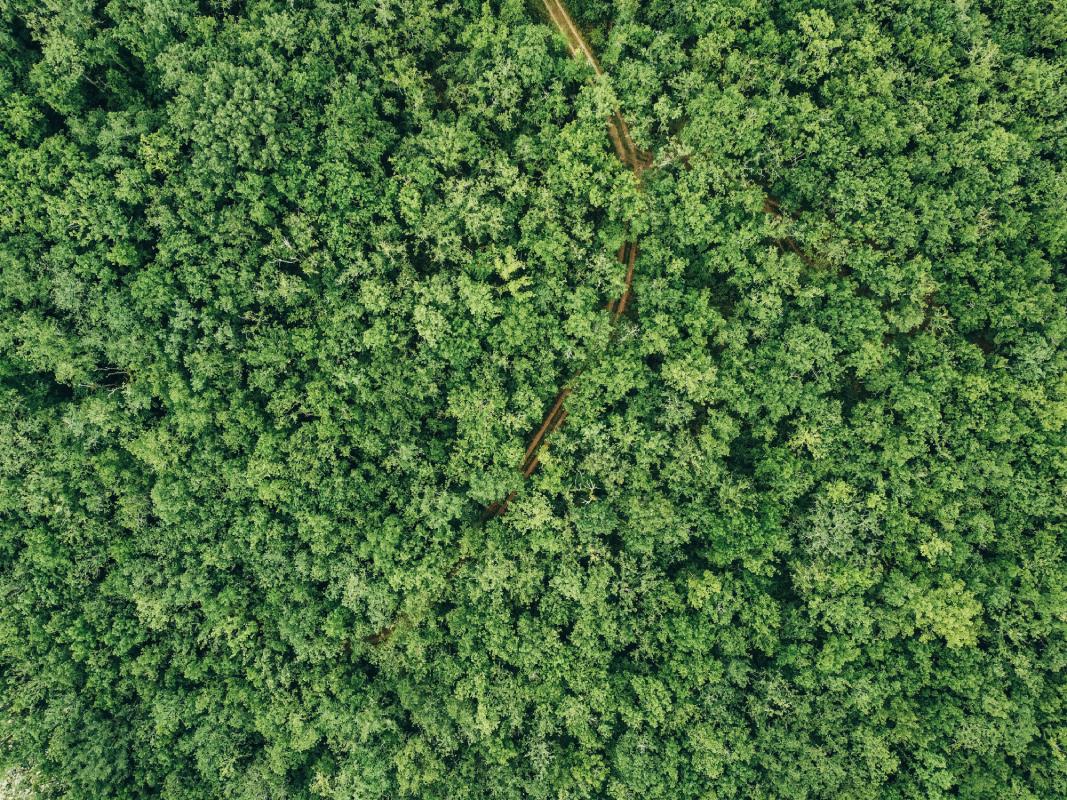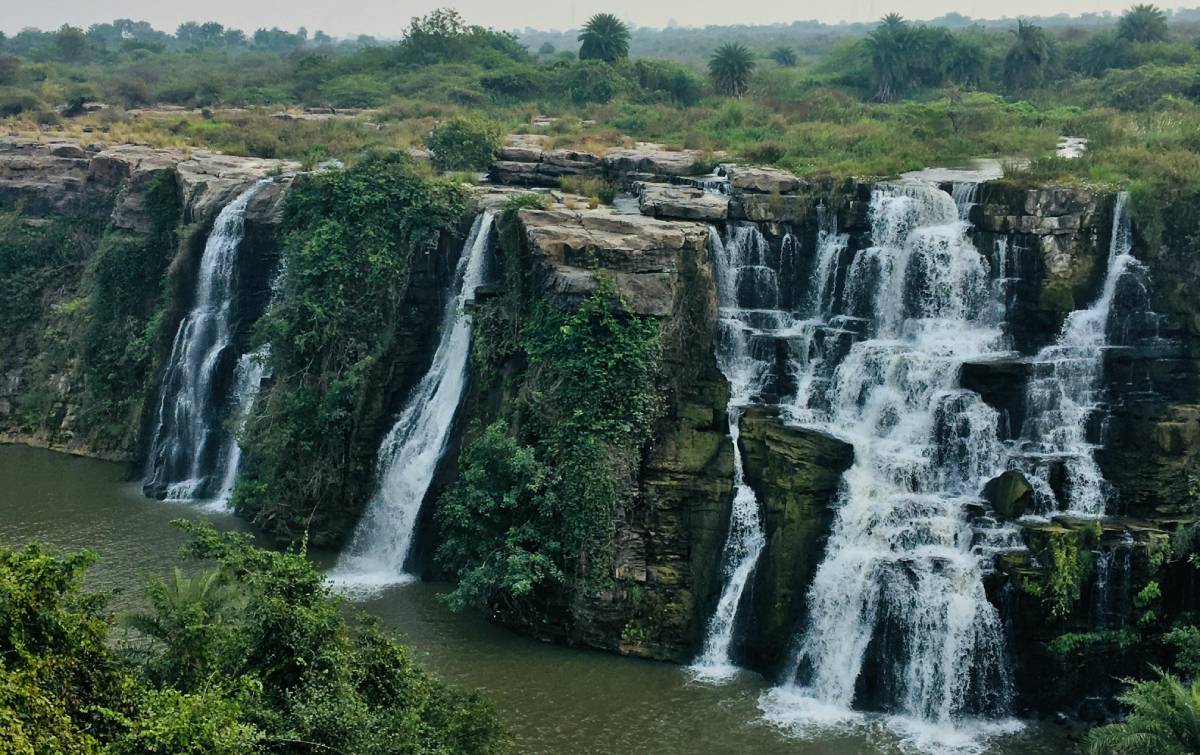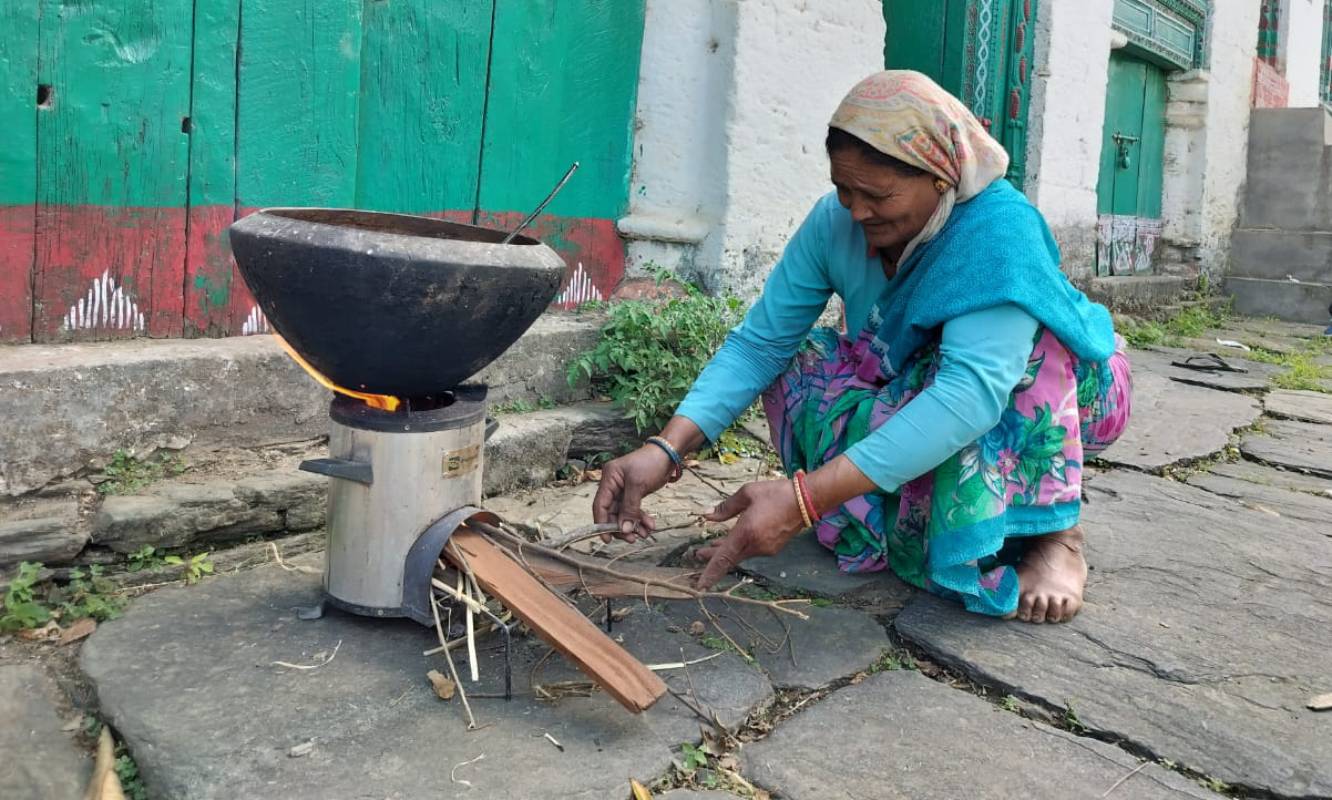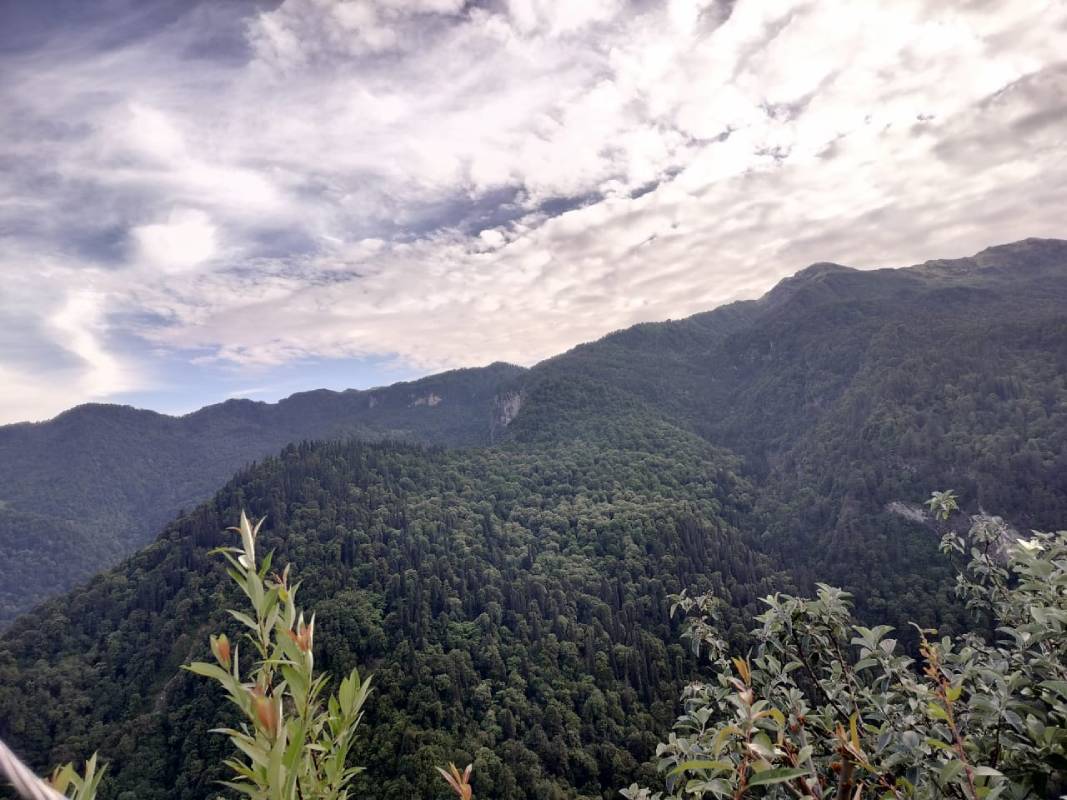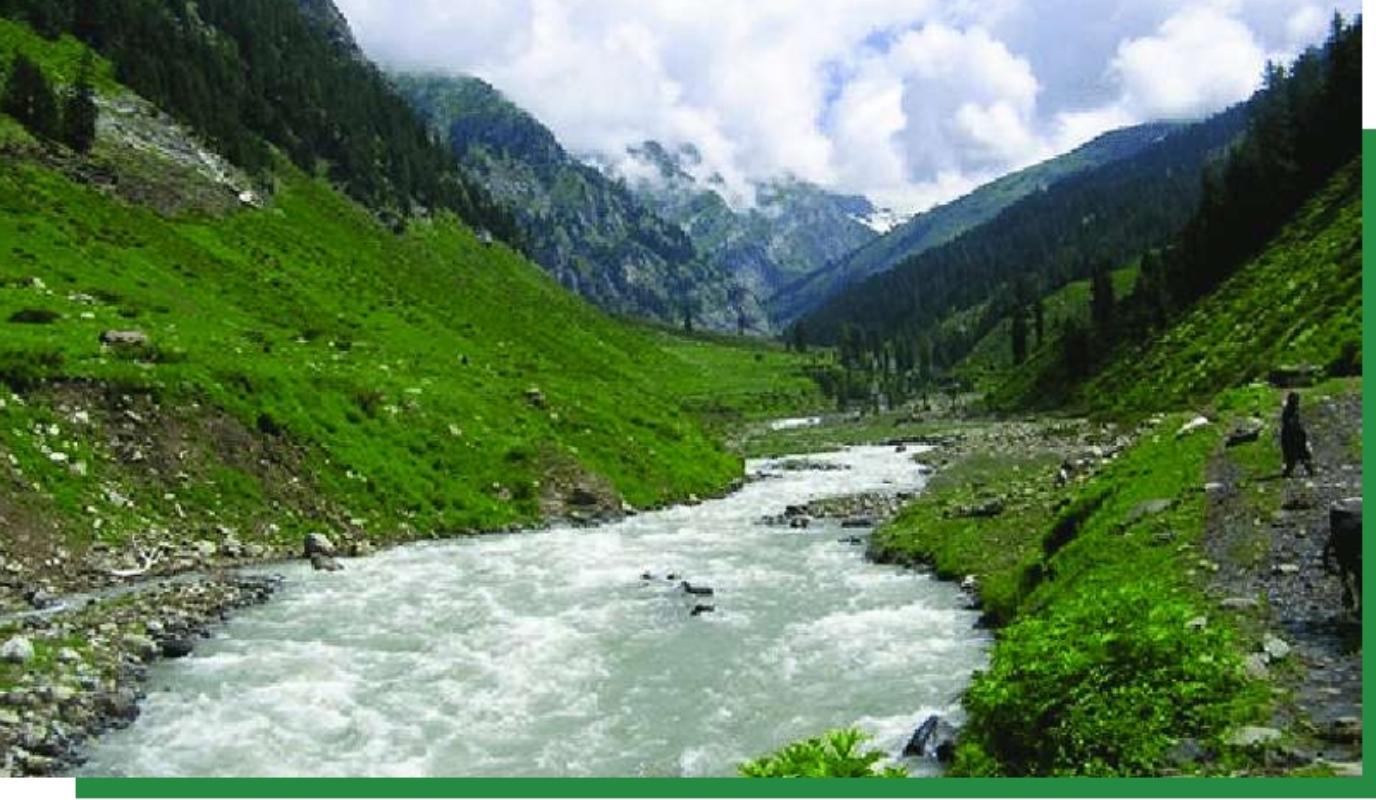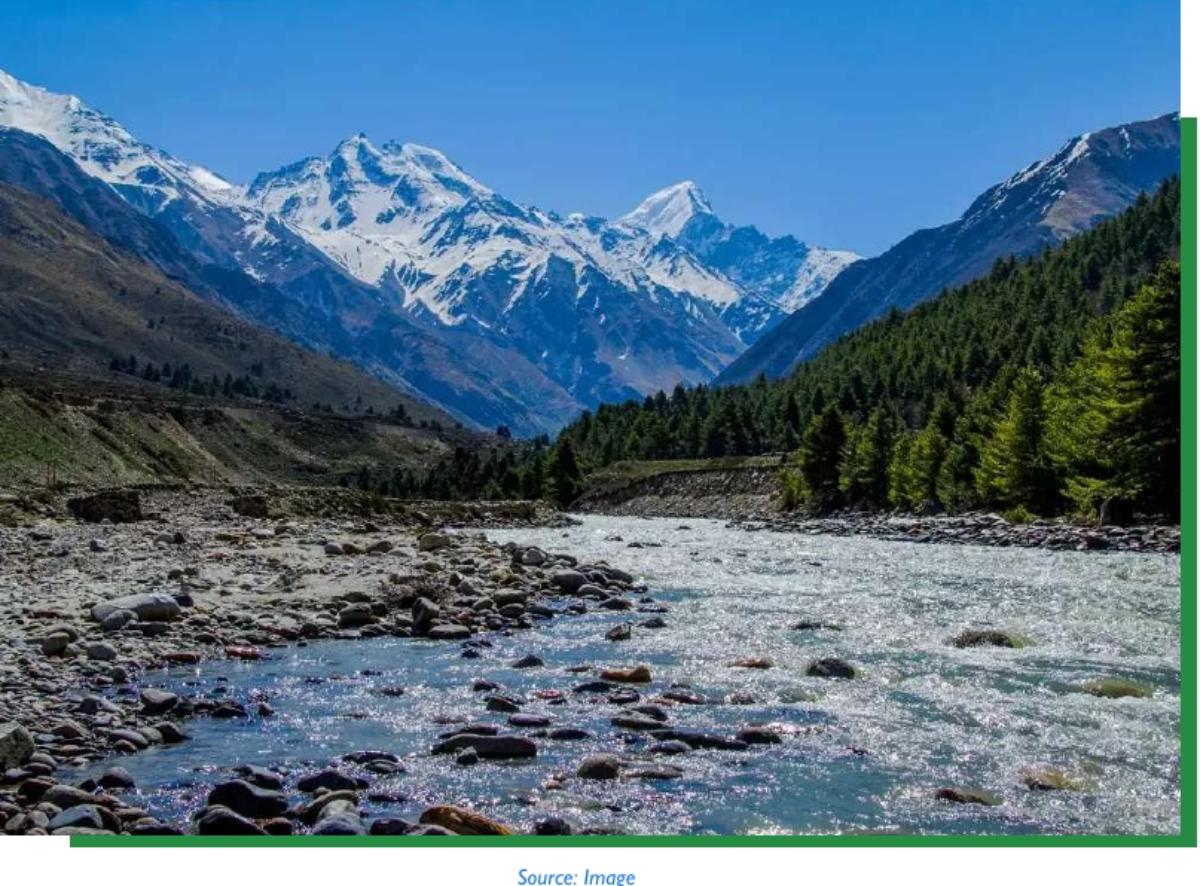Overview
The village Payvihir is nestled at the foothills of the Melghat range in the Amravati district in north east Maharashtra. The Satpura range in the north separates the district from the state of Madhya Pradesh. The region boasts of a hot and dry climate with the monsoons season stretching from June to October. The average rainfall is 700-800mm in the region. The temperature in summer can go as high as 46° C, whereas in winters it can dip to 11°C.
Located in the Achalpur taluka of Amravati district, Payvihir is a medium sized village. It is home to 110 families mostly belonging to the Korku tribe and some Balai families. The population of the village as of Census 2011 was 490, with 255 males and 235 females. The literacy rate in 2011 for the village was 64.48%, which is speculated to have increased in the recent years as per the locals.
The story of Payvihir village in Amravati district of Maharashtra began with water scarcity, migration, and poverty, like many other tribal villages across the country. It was when a few literate youth became acquainted with an NGO and learnt about their rights that the fight for a better future began. The village united and got the community ownership of their traditional forest land as ‘Community Forest Right’ (CFR) through the Forest Rights Act (2006). However, the forest land was highly degraded.
Through Joint Forest Management ( JFM), Mahatma Gandhi National Rural Employment Guarantee Act/Scheme (MGNREGA) and other related schemes, the people began work on the forest and within a few years the forest started regenerating. Water became available again within the village for the people to practise agriculture and birds and animals started visiting the forest again. There was enough fodder again available in the forest for the villagers of Payvihir to be able to rear cattle and livestock. MGNREGA and works under JFM brought employment opportunities within the village and reduced outmigration for work. Today, Payvihir is an example of how schemes such as FRA, JFM and BDA can be successfully implemented at a decentralised level to bring meaningful development in marginalised people’s lives and give them a better standard of living.
The ownership of a forest has completely changed the lives of the people of Payvihir. With the availability of work in the village, people stopped migrating out. Soil and water conservation works rejuvenated the groundwater levels, making it possible for the villagers to dig borewells in the village and install taps in all households. All of this has increased enrollment of children in school, improved the health and nutrition status of the villagers, and improved the outcome of agriculture with water available for irrigation.
The many works carried out on the CFR land such as plantations and soil and water conservation works created employment opportunities for the villagers around the year through MGNREGA. With work available in the village itself, families stopped migrating out for work.
The forest received under CFR has a huge patch of custard apple and tendu trees which have become a major business opportunity for the Payvihir Gram Sabha. This case study looks closely at the process and challenges of implementing FRA in a tribal village in Maharashtra to understand how such a model can be replicated elsewhere.
Payvihir Forest and Forest Based Livelihoods
Payvihir is located along a reserved forest on which the people of the village were dependent for majorly fuelwood needs. The approximately 192 ha of forest area which the people of the village traditionally accessed was degraded and under-stocked with heavy soil erosion and water runoff. The soil types found in the forest are sandy clay loam, gravelly clay loam and gravelly sandy loam.
The major tree species found in the area are palash, tendu, bharati and sitaphal. Other species that constitute the vegetation are neem, nirguri, bor, khair, amaltas, babul, rosha grass and kusa grass amongst others. The girth of the trees indicate a young forest although it might have had slow growth due to high soil water run-off. The wildlife found in the forest includes jungle owl, grey partridge, lizard porcupine, wild boars, bear and deer. Occasionally leopards and snakes are also spotted in the area. The water level was extremely low in the forest and the barrenness had barely enough food and fodder for the wild animals.
Before the CFR, a JFM committee used to manage the forest. However it only became active around a year before the village received their CFR rights. With the members of the village becoming active in the JFM, some soil and water conservation works were started with the help of MGNREGA. Prior to that, the reserve forest came under the jurisdiction of the state forest department. The people of the village were only able to extract fuelwood.
The villagers of Payvihir were mostly dependent on the forest for fuelwood. As recollected by the interviewees, people did not collect any Non-Timber Forest Produce (NTFP) before receiving CFR, as the forest was managed by the Forest Department.
There was a huge water crisis in the village in the 2000s. This made the practice of agriculture or rearing livestock or cattle difficult. Most villagers would migrate to other places to work as farm or contractual labourers to earn a livelihood. A major source of livelihood for the villagers back then was extraction of fuelwood in bundles, which they would then sell in the nearby city of Paratwada or Pathrot, a town nearby.
The issue of water scarcity in Payvihir was so grim that every day, in each household, one person had to stay back and trade off on work or education, just to ensure there was water in the house. There are no major water bodies near the village and drinking water had to be collected from a farm that had a borewell, at least a kilometre away. Villagers had so little water that even in extreme heat; they could either take a bath or use the water for cooking, cleaning and drinking. Agriculture could not be practiced due to the same reason.
All rainwater was lost due to surface runoff. This acute shortage of water to even survive, led to a need to do something in the village amongst some youth, who later on, took the leadership to claim for CFR. Water scarcity also impacted the scope of activities the people of Payvihir could take up to make a livelihood. Around 70% of households in the village do not own any land. Limited access to forest meant no income from MFPs or cattle/livestock (grazing in forest).
While the forest used to provide fuelwood and some area for grazing, that depleted highly over the years. Receiving the CFR and managing the forest would provide an opportunity to regenerate the forest and earn an income in the form of MFPs, grazing ground and regeneration activities.
The Community Mobilization Process in Payvihir
Claiming of community forest rights under the Forest Rights Act, 2006 requires consensus within the village, participatory planning and democratic process of decision making. These are not pre-requisites only for claiming forest rights but also determine sustainable and equitable usage of forest resources. However, the Payvihir village was deeply divided into two constantly fighting fractions. A group of young people from the village led by Mr. Ram Lal with the help of an NGO KHOJ – a quest for Knowledge Hope Opportunity & Justice – took this challenge to unite the village. This group used cultural and religious events, symbols and institutions to unite the village.
There were conflicts within the Korku community itself because of which there was segregation within the community. A few youth of the village, studying at an adivasi hostel in nearby town, who were childhood friends, realised this. There was so much segregation and conflict amongst villagers they could only meet at the hostel, despite being from the same village. They realized how this conflict amongst the community was detrimental to the future of the village.
This conflict would come forward when there was some event or festival in the village. Especially during festivals like Ganesh Chaturthi or Navratri. At that time they didn’t understand the need for development or such, and they were just concerned about their friendship. However, in a few years they realised that the survival of the village depended on the survival of the community. At the same time, they also met people from a local NGO- KHOJ at the village. This group of friends then approached the elders behind the two main groups and asked them what the reason for this conflict was; both of them started blaming each other. These young boys realized that they were just creating conflict amongst the villagers for their own greed. They started talking to the people of the village regarding this and stated the need to unite.
Around the same time Mr. Ram Lal, a part of this group of young men, participated in the andolan for NREGA as a volunteer with the NGO KHOJ. At the same time FRA was also being drafted. This made him realise even more the importance of unity in the village to be able to reap the benefits of these policies. Following this, he decided to set up another Ganpati in the village during Ganesh Chaturthi, a festival celebrated widely in Maharashtra. He with his friends announced that people from either group in the village can come and part of their Ganesh Chaturthi festival. People were confused as they would only go to the festivities of their group. However, the youth convinced them that this is God’s festival and there is no harm in eating food arranged at their stall. This proved to be a big step in bringing the people of the village together. Within two years, this young group of friends were able to unite their village. This was just in time as the FRA came about.
The group of youth also used the traditional institutional mechanism in the form of Jati Panchayat. The Korku community of the village had their own system of governance which is centuries old. They called this the Jati Panchayat. The existence of this system in the village, also helped in bringing people together for Gram Sabha meetings. Jati Panchayat is called Chawari in their local language. The system has a non-political head called the Mukhiya, there is a chundri who calls people to the meetings. It is compulsory to be attended by at least one member of each household.
Earlier the issues taken up in Jati Panchayat constituted issues in the community, such as any conflicts within the community, weddings, festivals, pooja or collection of funds and/or resources for these activities. The Mukhiya had the authority to resolve conflicts anywhere, anytime. Big events in the village like festivals or weddings could be initiated only in the presence of the Mukhiya. The villagers after discussing the Forest Rights Act, 2006 agreed to use the Chawari as Gram Sabha for under the FRA, 2006. Today, along with its traditional tasks, the Chawari is functioned as an effective Gram Sabha in Payvihir.
The nature of issues discussed in Jati Panchayat changed as it became gram sabha. The Gram Sabha meetings are recorded in writing. One of the reasons CFR implementation has been successful is because the system of Jati Panchayat, a way of bringing people together, was alive in Payvihir.
Exposure Visits and Support from Forest Officials
While in the process of mobilizing villagers and bringing unity, the group Korku youth also filed a claim of community forest right (CFR) under the Forest Rights Act, 2006. In this process the team of KHOJ helped them in filing claims.
An exposure visit was arranged by the forest department in 2011. This was after the claim was submitted. It was crucial to show the rest of the villagers that it was really possible. Around 13-14 people from the village including women went to Mendalekha. People were impressed to see that getting rights over forest land was actually possible, as this was also an adivasi community that lived and worked in a similar manner. And they had won rights over a dense forest.
After that, they went to Hiware Bazar village in Maharashtra. This village does not have a tribal community, but the gram panchayat managed to work in a partnership with the forest department through the JFM on water conservation in watershed and plantation. That is where they learnt that JFM can be a channel of funding through which they could regenerate the forest. For the people of Payvihir, Mendalekha was an example of a governance model of decentralisation and Hiware Bazar was a model of utilising JFM for water conservation and forest regeneration. Pictures taken in these exposure visits were shown to the rest of the villagers on their return and this had a huge impact on the people.
After the exposure visit, an expert, forester C Sreenivasan was called to better understand the forest, and the kind of work that should be done. However, people were still hesitant to believe it would happen to their village. The NGO KHOJ facilitated in bringing the Chief Conservator of Forest (CCF) Mr. Mohan Jha to the village in 2011. This was the first time that in their village 17-18 cars came with a red beacon. The entire village waited for them and Mr. Jha sat with the villagers. This made the villagers believe in the youth. The elders especially felt that they must be doing something right if they could call a forester of that position to the village.
Mr. Jha told the villagers that the forest was theirs and the foresters were with them. He asked about the JFM, and that is when the JFMC became active in Payvihir. This way NREGA work started in the forest. Finally in June, 2012, Payvihir was allotted CFR on 192.98 Ha of forest land benefitting a total of 113 Korku and Balai families in the village.
Community Led Regeneration of Payvihir Forest
The Payvihir village has travelled a long way from claiming degraded forest land to regenerating it and finally promoting forest based sustainable livelihoods. Following are few factors which contributed in this successful and replicable achievement of the Payvihir.
People’s participation and leadership
One of the most crucial factors in the successful implementation of FRA in Payvihir has been an active and engaging community. The leadership taken up by a few youth in uniting the community and then actively participating in the process of claiming and then managing CFR has been crucial. The gram sabha of the village recognises its authority in a decentralised governance structure and fearlessly asserts it. With the help from government departments and KHOJ, they have kept themselves updated with the knowledge and technical expertise required to manage their forest and develop their village.
The traditional governance system of the village known as jati panchayat made it easier to bring to- gether people of the village to disseminate information about FRA. This old system has been moulded into what is now the gram sabha of the village. The jati panchayat ensured there was a sense of community in the village which has translated into a strong, united and empowered gram sabha of Payvihir. Where earlier, personal matters were discussed in the jati panchayat meetings, issues of CFR and biodiversity management and overall development have become more important in the meetings of the gram sabha.
Institutional Innovations at the Village Level
Even after getting the CFR title and years of managing the CFR land, the awareness campaign man- aging the resources such as forest, fuelwood, and especially water continue within the village. These topics are regularly taken in gram sabha meetings and are an important topic of discussions in the Mahila Sangh as often the women are the ones managing water resources in the household. Water karamcharis have been appointed in the village to ensure there is no wastage or leakage at any point in the village.
One peculiar and clever management scheme of the villagers in Payvihir has been the uniformity of members across committees formed for management of forest. The committee elected by the gram sabha to carry out the duties as under section 5 of the FRA has the same members as the JFM committee and the Biological Diversity Management Committee. The uniformity in the committees has eased the decision-making process and reduced the chances of conflict.
The group of youth who initiated the process of claiming for FRA have never taken any position of authority within any committee in the village. Rather, all people of the village are encouraged to take up different positions in these committees to ensure active participation and instil a sense of responsibility and inclusion in them.
Managing Commons across Villages
The Gram Panchayat of Upatkheda, of which the village Payvihir is a part, collectively manage around 1200 ha of forest land under CFR titles. The four villages in the GP are in constant contact and design their management plans together. If one village faces a conflict, the other three also come forward to facilitate conflict resolution. This has helped build community resolution, mitigating measures and unity amongst the villages.
How Shalikram’s Life changed for the better due to development in his village Payvihir
Shalikram’s story illustrates how one household amongst many, has benefited from schemes through convergence.
For all his life Shalikram used to work as a servant in the nearby town (big village) of Pathrot. When the milch cattle scheme of the forest department was introduced in the village, Ramlal suggested that Shalikram get a buffalo. The scheme implemented by the JFM and Gram Sabha provided a buffalo or cow to beneficiary households at the cost of Rs 52,000. The amount for the cattle would be paid in parts by the forest department, the gram sabha (as a loan on 0% interest) and the rest by the beneficiary. Shalikram did not have any farm land and wondered how he would arrange for fodder if got cattle and hence, was hesitant to apply for the scheme. He was assured by Ramlal that he could get fodder from the designated CFR land. After convincing a lot, he finally got a buffalo and sold its milk.
Within a few years, Shalikram’s cattle increased and out of the 6 buffaloes he had, 4 regularly gave milk. He was able to earn Rs. 2000 weekly. His son also joined in looking after the buffaloes and would take them for grazing. Gradually, his condition improved so much that he started farming in a sharecropping agreement with a farmer, for whom he earlier used to work as a servant. In the year 2021, he decided to sell 4 of his buffaloes. Since his buffaloes were of very high value as they used to provide a lot of milk, he was able to make enough money out of it to buy 2 acres of farmland.
Today, Shalikram is no longer a servant, he is a farmer, with his own land and a milch cattle rearer who daily supplies milk to many households in the village.
Support of the Maharashtra State Government Departments
The case of Payvihir demonstrates how a good system can work. While the people are willing and driven, the government is also responsive. Throughout the claim-making and management process, Payvihir has been supported by the forest and tribal department with technical expertise and knowledge. One major milestone in this regard has been the District Convergence Committee which calls for the convergence of all line department schemes at the district level for holistic de- velopment of CFR management plans1. Through convergence, the village of Payvihir benefited in the form of soil and water conservation through MGNREGA, drip irrigation in forest land through JFM, cement and jaali bandhaare through JFM, Solar plants through Vidarbha Maha Mandal Board and JFM, Biogas plant through the tribal department, interpretation centre from Collector’s fund amongst others.
Sustainability of Payvihir Model
One of the most crucial factors in the successful implementation of FRA in Payvihir has been an active and engaging community. The leadership taken up by a few youth in uniting the community and then actively participating in the process of claiming and then managing CFR has been crucial. The gram sabha of the village recognises its authority in a decentralised governance structure and fearlessly asserts it. With the help from government departments and KHOJ, they have kept themselves updated with the knowledge and technical expertise required to manage their forest and develop their village.
An instance to understand the strength of the Gram Sabha and their understanding of decentralised governance was during the COVID 19 pandemic. The Gram Sabha at Payvihir was able to save money received in schemes by getting works done in lesser amounts. For instance cement bandhare costs Rs. 8-10 lakh by the government. The Payvihir gram sabha was able to do this work for Rs. 2,60,000. The government gave them Rs. 25 lakhs for check dams which they were able to build in Rs. 12 lakh. When the government got to know, they asked for the money back which was not proposed for any project. The gram sabha decided not to return it back as it was their saving. They had not used corrupt measures, and saved the money for their development. They said we will propose new projects. The gram sabha understood their authority in keeping the money with them.
Active Participation of Villagers in Management Activities
The traditional governance system of the village known as jati panchayat made it easier to bring together people of the village to disseminate information about FRA. This old system has been moulded into what is now the gram sabha of the village. The jati panchayat ensured there was a sense of community in the village which has translated into a strong, united and empowered gram sabha of Payvihir. Where earlier, personal matters were discussed in the jati panchayat meetings, issues of CFR and biodiversity management and overall development have become more important in the meetings of the gram sabha.
The group of youth who initiated the process of claiming for FRA have never taken any position of authority within any committee in the village. Rather, all people of the village are encouraged to take up different positions in these committees to ensure active participation and instil a sense of responsibility and inclusion in them.
Even after getting the CFR title and years of managing the CFR land, the awareness campaign managing the resources such as forest, fuelwood, and especially water continue within the village. These topics are regularly taken in gram sabha meetings and are an important topic of discussions in the Mahila Sangh as often the women are the ones managing water resources in the household. Water karamcharis have been appointed in the village to ensure there is no wastage or leakage at
any point in the village. 1
Custard Apple Business by the Gram Sabha of Payvihir
The forest received under CFR has a huge patch of custard apple and tendu trees which have become a major business opportunity for the Payvihir Gram Sabha. The custard apple produce from the forest was earlier auctioned by the forest department to traders. The people of Payvihir at that time in 2012, had no idea how to run a business. They were able to bring a trader to their village to sell the fruit and the first year itself they made a turnover of Rs. 40,000 and a profit of Rs. 16,000 for which a bank account in the name of gram sabha was opened. They realised that the
custard apple business had a lot more potential.
The Gram Panchayat of Upatkheda, of which the village Payvihir is a part, collectively manage around 1200 ha of forest land under CFR titles. The four villages in the GP are in constant contact and design their management plans together. If one village faces a conflict, the other three also come forward to facilitate conflict resolution. This has helped build community resolution, mitigating measures and unity amongst the villages.
How Shalikram’s Life changed for the better due to development in his village Payvihir
Shalikram’s story illustrates how one household amongst many, has benefited from schemes through convergence.
For all his life Shalikram used to work as a servant in the nearby town (big village) of Pathrot. When the milch cattle scheme of the forest department was introduced in the village, Ramlal suggested that Shalikram get a buffalo. The scheme implemented by the JFM and Gram Sabha provided a buffalo or cow to beneficiary households at the cost of Rs 52,000. The amount for the cattle would be paid in parts by the forest department, the gram sabha (as a loan on 0% interest) and the rest by the beneficiary. Shalikram did not have any farm land and wondered how he would arrange for fodder if got cattle and hence, was hesitant to apply for the scheme. He was assured by Ramlal that he could get fodder from the designated CFR land. After convincing a lot, he finally got a buffalo and sold its milk.
Within a few years, Shalikram’s cattle increased and out of the 6 buffaloes he had, 4 regularly gave milk. He was able to earn Rs. 2000 weekly. His son also joined in looking after the buffaloes and would take them for grazing. Gradually, his condition improved so much that he started farming in a sharecropping agreement with a farmer, for whom he earlier used to work as a servant. In the year 2021, he decided to sell 4 of his buffaloes. Since his buffaloes were of very high value as they used to provide a lot of milk, he was able to make enough money out of it to buy 2 acres of farmland.
Today, Shalikram is no longer a servant, he is a farmer, with his own land and a milch cattle rearer who daily supplies milk to many households in the village.
Support of the Maharashtra State Government Departments
The case of Payvihir demonstrates how a good system can work. While the people are willing and driven, the government is also responsive. Throughout the claim-making and management process, Payvihir has been supported by the forest and tribal department with technical expertise and knowledge. One major milestone in this regard has been the District Convergence Committee which calls for the convergence of all line department schemes at the district level for holistic de- velopment of CFR management plans1. Through convergence, the village of Payvihir benefited in the form of soil and water conservation through MGNREGA, drip irrigation in forest land through JFM, cement and jaali bandhaare through JFM, Solar plants through Vidarbha Maha Mandal Board and JFM, Biogas plant through the tribal department, interpretation centre from Collector’s fund amongst others.
Benefits to CFR villages by Maharashtra Government
The CFR title did not just give the ownership of forests to people but also opened up avenues for development in other areas. The CFR villages have been made the agency for implementing MGNREGA works in their forest and village, giving them the authority to decide the works best suited to their village and implementing them. CFR villages in Maharashtra got the benefits of a host of schemes under convergence. In October 2016, the Maharashtra government issued a Government Resolution (GR) on the formation of the District Convergence Committee to boost implementation of conservation and management plans in CFR villages.
Effective and Innovative use of Joint Forest Management Scheme
The JFMC became active around a year before receiving the CFR title. The people of Payvihir had been exposed to the potential of JFM in Hiware Bazar village in Maharashtra. They were quick to realise that JFM could be a great source of funding for forest regeneration and management projects which is why the JFMC is still active and utilised till date to acquire funding for forest related projects. The first watershed activities to address soil erosion were implemented through JFM. CCT was constructed on 30 ha of forest in 2012.
The Maho-bandh dam was constructed with funding received from Maha Jaluk Shivir through JFM in 2014. A milch cattle scheme was implemented via JFM in 2015 which benefited 12 households. A 5.5 HP solar motor and bore well were installed via JFM in 2016. Cement bunds, stone bunds and solar fencing also came to the CFR land through JFM.
The many plantations carried out by the villagers with the help of MGNREGA and JFM have helped revive the degraded forest and brought back birds and wildlife that had not been spotted for years. Payvihir’s impressive work on their CFR land has helped them get the benefit of convergence schemes and CSR funds to further protect and manage their forest. Through such schemes, a solar drip irrigation plant, a forest pond, a biogas plant, and works like continuous contour trenches (CCT) and Water Absorbent Trench (WAT) have been done on the CFR land.
Sustainability of Payvihir Model
One of the most crucial factors in the successful implementation of FRA in Payvihir has been an active and engaging community. The leadership taken up by a few youth in uniting the community and then actively participating in the process of claiming and then managing CFR has been crucial. The gram sabha of the village recognises its authority in a decentralised governance structure and fearlessly asserts it. With the help from government departments and KHOJ, they have kept them- selves updated with the knowledge and technical expertise required to manage their forest and develop their village.
An instance to understand the strength of the Gram Sabha and their understanding of decentralised governance was during the COVID 19 pandemic. The Gram Sabha at Payvihir was able to save money received in schemes by getting works done in lesser amounts. For instance cement bandhare costs Rs. 8-10 lakh by the government. The Payvihir gram sabha was able to do this work for Rs. 2,60,000. The government gave them Rs. 25 lakhs for check dams which they were able to build in Rs. 12 lakh. When the government got to know, they asked for the money back which was not proposed for any project.
The gram sabha decided not to return it back as it was their saving. They had not used corrupt measures, and saved the money for their development. They said we will propose new projects. The gram sabha understood their authority in keeping the money with them.
Active Participation of Villagers in Management Activities
The traditional governance system of the village known as jati panchayat made it easier to bring together people of the village to disseminate information about FRA. This old system has been moulded into what is now the gram sabha of the village. The jati panchayat ensured there was a sense of community in the village which has translated into a strong, united and empowered gram sabha of Payvihir. Where earlier, personal matters were discussed in the jati panchayat meetings, issues of CFR and biodiversity management and overall development have become more important in the meetings of the gram sabha.
The group of youth who initiated the process of claiming for FRA have never taken any position of authority within any committee in the village. Rather, all people of the village are encouraged to take up different positions in these committees to ensure active participation and instil a sense of responsibility and inclusion in them.
Even after getting the CFR title and years of managing the CFR land, the awareness campaign managing the resources such as forest, fuelwood, and especially water continue within the village. These topics are regularly taken in gram sabha meetings and are an important topic of discussions in the Mahila Sangh as often the women are the ones managing water resources in the household. Water karamcharis have been appointed in the village to ensure there is no wastage or leakage at any point in the village.
Custard Apple Business by the Gram Sabha of Payvihir
The forest received under CFR has a huge patch of custard apple and tendu trees which have become a major business opportunity for the Payvihir Gram Sabha. The custard apple produce from the forest was earlier auctioned by the forest department to traders. The people of Payvihir at that time in 2012, had no idea how to run a business. They were able to bring a trader to their village to sell the fruit and the first year itself they made a turnover of Rs. 40,000 and a profit of Rs. 16,000 for which a bank account in the name of gram sabha was opened. They realised that the custard apple business had a lot more potential.
Before the season’s sale, a group of youth was sent to the nearby city of Akola to explore the market. A separate team was made to collect and pack the fruit. And a team of youth would go to the market to sell the fruit. In the second season, they had a turnover of Rs. 2.75 lakh out of which Rs. 72,000 was their profit. Within a year of getting the CFR title, a forest that was degraded was giving people employment and a business opportunity. This strengthened their will to protect and manage their forest better and reinstated trust within the community to work together. In the subsequent years they took their fruit to farther markets of Nagpur and even to Mumbai.
By 2017, they created a brand called Melghat Naturals. They observed the market and also worked on their packaging and branding accordingly, as they observed people selling in boxes, they also got boxes to sell the custard apple in cities. KHOJ helped in making these boxes. Their profits continued to surge throughout the years. However, in 2018, a fire struck the forest and destroyed their custard apple trees. It is expected that the patch of trees will be ready with produce by 2023.
Going Beyond Payvihir to Other Villages in their Gram Panchayat
Payvihir’s lessons were first spread to the other three villages of the Gram Panchayat of Upatkheda, of which the village Payvihir is a part. These villages now collectively manage around 1200 ha of forest land under CFR titles. The four villages in the GP are in constant contact and design their management plans together. If one village faces a conflict, the other three also come forward to facilitate conflict resolution. This has helped build community resolution, mitigating measures and unity amongst the villages.
Biodiversity Park in Upatkheda
In the Gram Panchayat Upatkheda (of which Payvihir is a part), a Biodiversity Park has been constructed on Upatkheda village’s CFR land.
The park is a repository of local biodiversity and attracts various birds as well. The park consists of a nursery, garden, teak park, non-timber park, oil garden, bamboo garden, sitaphal patch, and a Melghat park consisting of all dominant species of trees found in the Melghat region and a bird watching tower amongst others.
The park is expected to become a popular picnic spot for locals, especially school children, who would be able to enjoy as well as learn about the biodiversity in their region.
Going Beyond their Panchayat to Other CFR villages
Payvihir villagers reached out to other villages in the district and in nearby districts to work together. They found one common link in the tendu patta business, in which the tender leaves of Diospyros melanoxylon are plucked and shade dried and bundled, for transporting to beedi production factories. After getting CFR, the Gram Panchayats were supposed to run this business.
Payvihir took the lead in explaining to the others how this business can be done profitably. Today, they have a federation of 40 CFR villages from which they earn Rs 1.5-2 Crore every year. KHOJ assists them with legal paperwork. In 2022, they are planning to sell a pack of 1000 leaves for Rs. 4,650. The gram sabha has become a business entity which maintains all paperwork and is audited every year.
Today, they have a federation of 40 CFR villages from which they earn Rs 1.5-2 Crore every year. KHOJ assists them with legal paperwork. In 2022, they are planning to sell a pack of 1000 leaves for Rs. 4,650. The gram sabha has become a business entity which maintains all paperwork and is audited every year.
Awards and Recognition
From a degraded forest, soil erosion and water scarcity, the village of Payvihir has come a long way to now be known as an ‘eco village’.2 For its impressive work on soil and water conservation and afforestation on CFR land, Payvihir was awarded the UNDP’s Biodiversity Award in 2014, giving the village a cash prize of Rs. 1 lakh and a citation. For its contribution to environmental conservation, the village was awarded the Maharashtra Wildlife Service Award presented by Sanctuary Asia in 2015.
Click.on-h. link below to watch a. video on Payvilhir:
-https://y outu.be/akA6BJCKV84
Footnotes:
1 Sahu et al, 2019b
2 thebetterindia, 2017

